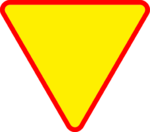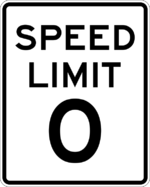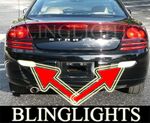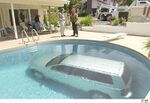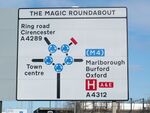HowTo:Drive Safely
Every day billions of people die in car crashes. This is a crash course in how not to crash. The author assumes the following:
- You already know how to drive dangerously.
- You live in a country where human-powered vehicles, such as bicycles, unicycles, wheelbarrows, jet packs, and pogo sticks are legally considered to be pedestrians, and are thus permitted to violate rules that other vehicles would normally have to follow, such as being operated on the correct side of the road.

|
HowTo This article is part of Uncyclopedia's HowTo series. See more HowTos |
Step One: Follow the "One Step Lower" Method[edit]
A lot of the crashes that occur today could be avoided if there were simply fewer vehicles on the road at any particular time. Thus, one should try to be on the road for as little time as possible. Following this advice, you can utilize what is known in driver's education circles as the "One Step Lower" method. This pertains to how one should react upon approach of controlled intersections. This method is as follows:
Yield Sign[edit]
You can disregard this sign. These are most often placed at locations such as acceleration lanes merging onto a highway or a traffic circle. In all instances, the other vehicles to whom the sign directs you to yield can see you coming, and should have plenty of time to slam on their brakes and let you go in front of them. The only exception to this would be if there is a single lane being used as both an exit ramp and an entrance ramp. In this case the vehicle accelerating should yield to the vehicle that is decelerating.
Stop Sign[edit]
Treat this like a yield sign. As soon as you can tell that other vehicles can possibly avoid you, accelerate quickly and proceed through the intersection, regardless of other factors.
Red Light[edit]
A red light is basically a stop sign with a long-term stop so it stands to reason that you must drive through a red light even faster than you would a stop sign. Some red lights aren't even related to traffic and have much more to do with prostitution (red light districts) or flying reindeer. The best course of action is to completely ignore all lights of any color while driving.
NOTICE: If you are correctly following this method, the only time you will stopped more than momentarily is if you encounter both a red light and a stop sign at the same intersection.
Step Two: Always Exceed the Speed Limit[edit]
Contrary to popular belief, the speed limit is NOT the maximum speed for the roadway under ideal conditions. Rather, it is the minimum speed for the roadway in the worst-case scenario. If heavy traffic causes your speed to drop below said minimum speed assume that this situation has been caused by a car you can see in the distance and force every 2, 3, 4 lane, or more, undertaking opportunity that presents itself (sounding one's horn will not only server to rouse elderly road users but will also decrease other road users reaction times); soon you will be alongside said vehicle, flick them off and pick a new target should your original guestimation have proved false.
Step Three: Be Assertive[edit]
When you are operating a motor vehicle, you must be assertive. You can't let some stupid pedestrian cross the street in front of you. You are in a vehicle, he is walking. Keep this in mind:
- You can travel much farther than across the street in the time you would be stopped to let him cross.
- The road is for cars, not people. That's what we have buildings for.
- Car versus person. Who do you think is going to win?
- By running the pedestrian over, you are simply proving Buddha's idea of "Survival of the Massive" (AKA the Displacement Theory).
Another great way to be assertive is to roll your vehicle over in front of a large group of people. This lets them know you mean business and are not some kind of "shiny side up" pussy. If you can learn to exit the vehicle while it is still spinning around on its roof, onlookers will think you're a god. A god.
- Correct use of the parking (hand)brake must be considered at all times, should a space avail itself the astute driver should be able to position the vehicle by applying the parking (hand)brake whilst the vehicle is still in motion. Properly practised, this method will not only leave on lookers wet with excitement as you screech to a halt but is also the fastest and thus safest method to end one's journey.
Step Four: Properly Use Vehicle Equipment[edit]
Your vehicle is probably equipped with all kinds of the latest safety devices and mechanisms, but they are worthless to prevent a collision unless you know how to use them properly.
Daytime Running Lights[edit]
As the name implies, these lights are for use when you are in a hurry and don't want pedestrians getting tangled up in your wheels, slowing you down. Turning on daytime running lights gives pedestrians a bit of a warning to start running as you approach.
Fog Lights[edit]
Use these whenever you feel like it. These lights generate fog which gives your car a cool look.
Hazard Lights[edit]
This mechanism, also called four-way flashers, causes all of the vehicle's turn signals to flash. This mechanism is intentionally designed to override use of a single turn signal and, in certain vehicles, can disengage any brake lights. These are unnecessary while you have your hazard lights activated, which is strongly recommended anytime your vehicle is in motion. While your hazard lights are on, you should avoid using headlights, taillights, or brake lights. The flashing of the hazard lights indicates the movement of your vehicle to other drivers, and additional lights can be very distracting, particularly at night or when visibility is reduced, such as in rainy, smokey, or foggy conditions. Much fun can be had whilst driving at night; all other lights can be turned off and you can drive by the "strobe" effect of your hazard lights, this technique is particularly useful for attracting the attention of attractive law enforcement offices as you pass them. Another fun option is to paint your vehicle with glow-in-the-dark paint and shut off all your lights.
Headlamps[edit]
Also called headlights, headlamps are arguably the most useless thing man has ever come up with. The vast majority of the time, you should not use these. If you must use headlights, ensure that they are on the high-beam position when there is other traffic for enhanced visibility. However, it is acceptable to use low-beams for short durations, as long as there are no other vehicles around. With the advent of hazard lights, these are largely unnecessary while driving, although some experts maintain that driving with one's headlamps at its high-beam setting at night is acceptable under the right circumstances. Otherwise, you will use these lights when you are parked on the side of a highway or other roadway at night (for example, if your vehicle breaks down or you feel like wandering the highway by foot). If possible, you should have your headlights at maximum intensity (usually high-beam setting), and all of your other lights (parking lights, taillights, etc.) should be off. These are unnecessary since their purpose is to help people determine the location of your vehicle, particularly at night when there are few landmarks for perceiving depth. Nobody cares where you are, since you are stopped when everybody else behind you is going at least 75 miles per hour (see Step 2). Some people might be blinded by the glare, but don't let that concern you. Your ability to see the empty shoulder ahead of you is more important than everybody else's ability to see while they are driving.
Horn[edit]
Most people foolishly wait until a collision is imminent to sound their horn. Safe drivers know that they should jump out of the vehicle before a collision to avoid injury and liability. This hardly leaves time to sound the horn. The safe driver sounds his horn continuously whenever his vehicle is in motion as your horn will create a force field around your vehicle. Tape your horn button down for an inexpensive hands-free force field generator.
Parking Brake[edit]
Despite its suggestive name, this should never be used when parking, even when your vehicle has a manual transmission and is parked on a hill in neutral. This will wear out the brake, causing it to not be as effective when you try to drift. This is one of the most difficult parts about driving to master. In a properly executed drift, the vehicle should travel in a direction at least 45 degrees (preferably around 90 degrees) from the orientation of the vehicle. For more information, see "The 7 Habits of Highly Effective Drifters". Some people also like to use this device in vehicles with manual transmissions when they have to accelerate from a stop while on a hill. This is a very dangerous practice, and it can cause the vehicle's engine to literally fall out of the vehicle. It is recommended that one partially engages the clutch, just enough that the vehicle's engine can keep it in a stationary position. In Britain, the parking brake is known as the handbrake, as you operate it mainly with your hands. It is however, common practice to apply the handbrake whilst moving in Britain, especially at motorway speeds (70mph). This often results in such hilarity as flipping the car, causing multiple fatalities in motorway pile-ups and being a general mischievous scamp.
Seat Belts[edit]
Regardless of what your mum may have told you back in the 20th century, seat belts should NEVER be worn in vehicles equipped with airbags. Not only are they among the most annoying parts of a vehicle (second only to the automatic transmission), but they are dangerous as well. In the event of an accident, they may prevent you from being able to jump out the window while the vehicle is moving, which could result in you being stuck at the controls until the vehicle comes to a stop. Furthermore, this keeps you close to the vehicle, which could easily a splode. In the ultimate crash scenario, immediately after the impact you would leap through the windshield, such that you land in front of your car and can throw yourself against your car, impeding its movement.
Step Five: Always Drink and Drive[edit]
Driving, especially in heavy traffic, can be stressful, which can lead to mistakes. It is critical to avoid mistakes when you are behind the wheel of a vehicle, so it is recommended that you consume alcohol or take medication before you drive. You will be in a more relaxed mood, and will therefore be more prepared to handle whatever the open road can throw at you. Sleep aids seem to work particularly well. If you must drive immediately and haven't had a drink, be sure to bring your booze with you and drink while you drive. Grab a handful of pills to wash down as well. You're going to need to be in a relaxed mood to figure out how to dispose of that body you've got in the trunk (or "boot" for you Limey wankers). If you drive in the UK or other countries where Napoleon's cack-handed surrender monkey antics haven't affected you then we would also advise masturbating to relieve tension (if you are actually left handed or have given up on ever being able to drive a real car i.e. you drive an automatic, you are probably well practised at the above and can continue as usual safe in the knowledge we support your good habits).
Step Six: Enjoy the Scenery[edit]
It's vitally important to be aware of your surroundings while driving. How do you know if that horse out in the field is thinking of bolting right into your right-of-way ? You don't, so keep an eye on him. Also, there's not much point in driving if you're just looking at the boring pavement or vehicle in front of you. There's lots of interesting things in back of and especially to each side of your vehicle. Don't be afraid to leave the pavement and get a closer look at buildings, people, or shiny things. You'll likely be pleasantly surprised at the wide variety of surfaces on which your vehicle can operate. Driving is a great time to watch for UFOs as well.
The internal scenery of a vehicle can be equally as important and impressive; maybe it's your passenger's legs or those new seat covers you put in, either way "life moves pretty fast, if you don't look around you could miss it" - Nelson Mandela.
Step Seven: The Art of Drafting[edit]
With gas prices falling nationwide, more and more people are looking for ways to improve fuel economy. A simple and safe way to accomplish this is to draft. The basic concept is to find a large vehicle, preferably one with as expansive a rear blind spot as possible (such as a semi-tractor trailer or large omnibus) and drive behind it, as near to the rear of the vehicle as practicable. This improves fuel efficiency because the larger vehicle's slipstream greatly reduces drag. This is also safer, because the closer your vehicle is to the large vehicle, the less room there is for changes in velocity in the event of a collision. To demonstrate this, one can perform the following analogy: first, hit yourself in the stomach with your hand as hard as you can. Next, repeat this, except only allow your hand to move approximately a centimeter away from your stomach. In the latter, the collision will be much less forceful.
Step Eight: React to Emergency Vehicles[edit]
Legislators have spent thousands of years developing the laws that govern traffic, but there are some vehicles that seem to disregard this. Examples of such vehicles are fire trucks, ambulances, and law enforcement vehicles. Drivers of these vehicles will try to bully you into giving them right of way, often using flashing red or blue lights, sirens, horns, and other annoyances. Do not submit to them! If you start to abandon your right-of-way to other vehicles just because they have fancy equipment, then the guiding principles on which the Declaration of Independence is based would be thrown out the window. All men are created equal.
If the situation arises where you are able to follow one of the above mentioned vehicles whilst they are on their KFC run etc (this is easily identified by the fact that their sirens are on) then slip-streaming them can expidite your journey.
Perhaps the worst offenders, however, are law enforcement vehicles. The only things these drivers do is pull you over, even if you are following this guide to a tea. The best thing to do if you see a vehicle like this (some clues: the word "POLICE" displayed on the vehicle, a bar with flashing blue lights on the roof) approach you from behind is to drive at least 15 miles per hour below the speed limit (NOTE: This is the ONLY time that you should drive within the speed limit). Hopefully, the driver of the law enforcement vehicle will be so impressed with how slowly you can drive in the presence of a marked patrol vehicle that he will only write you two citations, instead of the five that you deserve. Yay!
Unmarked Vehicle Theory[edit]
If you live in the UK or other civilised areas you may come across unmarked Police vehicles from time to time, you may be familiar with these if you have ever followed any aspect of this guide. If you suspect that a vehicle ahead may offer you the ultimate retardation it is wise to slip-stream said vehicle, if he/she continues above the minimum speed limit it is safe to do likewise as any resulting ticket etc can be considered entrapment, either that or they are just an ordinary stiff with a very unfortunate taste in vehicle, continue said assertiveness until the vehicles' identity is no longer in question.
Step Nine: Park[edit]
Perhaps the most important part of driving is parking. This is simply because most people spend a great part of their day not in their cars. Once you have reached your destination, all the wonderfully epic maneuvers you have performed in the previous steps are worthless without a decent parking job. This section describes the who, what, where, when, why, and how about parking.
Residential Neighborhoods[edit]
In most residential neighborhoods, the best place to park is on the street. The street is the natural home for the automobile, and your vehicle will feel much more comfortable there than many other places people choose to park. Parking in the roadway will also make it easier to pull out into traffic upon your departure. On regular two-way roadways, the ideal parking position is in the middle of the street, with the vehicle oriented perpendicular to the curb. However, this is not always possible. If you find that you must park parallel to the curb, make sure you are parked as close to the center of the road as practicable. If there are no available spots in the middle of the road, the next most desirable location is to park such that your vehicle is facing oncoming traffic, which usually means parking on the left side of the street. It is recommended that you park close to as many driveways and rural mailboxes as possible. In the case that you cannot park on the street, park on the sidewalk. The least desirable place to park is a driveway, since parked cars will make it impossible to leave. You may have to park in a neighbor's yard, possibly right on top of your neighbor's vehicle.
Metropolitan Areas[edit]
When parking in busy metropolitan areas your safety is paramount; always ensure that the vehicles doors are opened fully and as quickly as possible without putting any of your body in the way, this will not only ensure that other road users have to slow down to avoid damaging their vehicles but may also result in reducing through traffic to a single lane making it much easier for chickens to cross the road.
Parking Attendants A.K.A. Traffic Wardens[edit]
Often paid on incentivised schemes, safe and practical parking can often best be demonstrated by placing your vehicle on-top of such individuals. Should the situation arise, chasing them down the street (whilst semi-naked), rhetorically questioning their mother's pride in their occupation, has been found to achieve satisfactory results.
Parallel Parking[edit]
Driving guides and instructors always make parallel parking out to be incredibly difficult, like assembling Ikea crap or something. This is because so many people become immersed in arcane regulations and traffic markings. In reality, parallel parking is extremely simple and can be outlined as follows:
- Pick a place to park.
- If the space is occupied by another vehicle and parking on top of it is impractical for some reason (other vehicle is too tall, will not crush easily, etc.) then simply park right next to or parallel to it.
- Done.
Perpendicular Parking[edit]
Sometimes, there is such a commotion at an event (such as one of my lectures on safe driving) that all areas regularly used for parking are full. In this case, you may have to park your vehicle in an unmarked lot, a field, on its side, on top of another vehicle, in a swimming pool (see figure 9.1), or on railroad tracks. This is all fine and dandy. If you have to park in a field or an unmarked lot (the least desirable of the options listed) and a lot of other cars are parked in a certain orientation, make sure you park so that your vehicle is perpendicular to it.
Figure 9.2
Other Vehicles __ __ __ __ __ __ __ __ [< ][ >] [< ][ >] [< ][ >] [< ][ >] [< ][ >] [< ][ >] [< ][ >] [< ][ >] [< ][ >] [< ][ >] [< ][ >] [< ][ >] [< ][ >] [< ][ >] [< ][ >] [< ][ >] [< ][ >] [< ][ >] [< ][ >] [< ][ >] [< ][ >] [< ][ >] [< ][ >] [< ][ >] [< ][ >] [< ][ >] [< ][ >] [< ][ >] [< ][ >] [< ][ >] [< ][ >] [< ][ >] [< ][ >] [< ][ >] [< ][ >] [< ][ >] [< ][ >] [< ][ >] [< ][ >] [< ][ >] [< ][ >] [< ][ >] [< ][ >] [< ][ >] [< ][ >] [< ][ >] [< ][ >] [< ][ >] [< ][ >] [< ][ >] [< ][ >] [< ][ >] [< ][ >] [< ][ >] _ [< ][ >] [< ][ >] [< ][ >] [< ][ >] |^| [< ][ >] [< ][ >] [< ][ >] [< ][ >] |U| [< ][ >] [< ][ >] [< ][ >] [< ][ >] |_| [< ][ >] [< ][ >] Your Vehicle (Properly Parked)
For Advanced Drivers[edit]
Roundabouts[edit]
Roundabouts are wonderful innovations which eliminate those annoying red lights at which uninformed drivers often come to a complete halt, thus putting the safe drivers behind them (who are accelerating) at unnecessary risk. Roundabouts are found in many parts of the world but almost never in North America. For this reason Americans should never attempt to negotiate a roundabout. Many roundabouts in London and other major cities are littered with the skeletons of Americans who became trapped in the inner lane and never escaped, ultimately dying of starvation or dehydration. Their remains are left in place as a warning to other Americans about the hazards of roundabouts and also just because it's really funny. For non-American drivers, roundabouts are relatively simple:
- Determine whether traffic is moving in a clockwise or counter-clockwise direction at the roundabout.
- But first make sure you can tell time and stuff and not just on a digital clock but on the old kind with hands.
- To avoid "circling the drain" and getting trapped like a stupid American, be sure to drive against traffic and head for the outer lanes.
- Exit when and where it's convenient, but feel free to go around a few times if you're having fun.
- If you have missed your exit, don't be alarmed; simply ignore whatever traffic may be in your way and head in a straight line to the exit, if anything too large to barge out the way blocks your path simply stop dead by performing an emergency stop with/without the parking (hand)brake, remember other road users will always stop for you to avoid damaging their vehicles.
- Do not assume others have read this guide, many enter a catatonic like state when faced with busy round-a-bouts; wildly gesticulating towards gaps that pensioners ahead may catch in their rear view mirrors, may have limited success however slowly nudging them into oncoming traffic always works and is the best use for bull-bars yet!
Speed Bumps[edit]
Often these are merely pedestrians in a prone position, but some speed bumps or humps are actually intentional parts of the road. The purpose of speed bumps is for you, the safe driver, to determine your speed without the distraction of having to look at your speedometer (if you have one). If you know how far apart the bumps are you can count the "clicks" as you pass over them. The number of clicks per second will help you determine your speed. Unfortunately, such bumps are not always evenly spaced and counting clicks involves doing math, so clearly the entire system is still in development.
Further Reading[edit]
- Why?:Can't Anybody Drive in this Town?
- Traffic Signs
- The Female Drivers' Guide to the Road (American Version)
